- | Regulation Regulation
- | Policy Briefs Policy Briefs
- |
Cutting Red Tape in Kansas: A Menu of Options
Regulation is pervasive in the United States and touches nearly every aspect of Americans’ lives. The labels on breakfast foods, the flow rate of water in the shower, and the fuel efficiency of cars are all regulated by the federal government. Regulations at the state and local levels affect whether Americans can obtain certain jobs, whether local pharmacists can write prescriptions for simple medications, and whether hospitals can add beds to their facilities. Moreover, the amount of regulation in the United States has grown steadily over time, a process known as regulatory accumulation. Each year new rules get added to the lawbooks, adding pages of new requirements. Yet typically few rules are removed to offset the growth. Thus, the regulatory environment grows more complex and omnipresent each year.
This policy brief aims to accomplish three tasks:
- Explain why people should care about regulation. As this paper shows, regulation matters for economic growth. GDP is not important in and of itself but rather because the wealth generated by growing GDP allows people to improve their living conditions and leave behind a better world for their children and grandchildren. In short, growth matters because it increases social welfare.
- Answer an enduring question for regulatory researchers: how much regulation is there? The Mercatus Center at George Mason University has created a number of datasets that cast light on how much regulation exists at various levels of government in the United States as well as elsewhere. Modern tools are being brought to bear to answer questions that have eluded researchers for a long time.
- Review efforts to reform regulatory procedures taking place in US states and elsewhere. The variety of reform efforts in these jurisdictions suggests a menu of options for policymakers.
This brief will focus on how regulation affects the state of Kansas, but many of the lessons presented here have relevance to policymakers in other states and to federal lawmakers in Washington, DC, as well. All told, Kansas is well positioned to be a leader in regulatory reform. Currently, it has one of the smaller regulatory volumes among US states, limiting the burden on state residents and businesses. Whether Kansas can maintain its competitive advantage, however, is an open question.
Why Care about Regulation?
As many Americans learn in high school civics class, elected representatives write bills, which, if passed by a legislature, can become statutes. These statutes are what most people imagine when they think of “law.” These statutes, however, also may delegate lawmaking powers to administrative agencies, which then craft regulations to execute those statutes. Regulations are laws written by administrative agencies (also known as regulatory agencies), and they often involve working out fine details not addressed in the original statutes. Sometimes the powers delegated from legislature to regulator are narrow, so the regulatory agency does not have much discretion when regulating. Other times the powers delegated are broad, such that regulating becomes virtually a form of lawmaking all its own.
People should care about regulation for several reasons. First, regulation raises questions about accountability, because in a democracy, government is supposed to be responsive to the public. The nominal justification for the existence of regulatory bodies is that regulators have expertise and are independent from politics. Legislators may not have time to become experts in every topic for which they write laws, and they may be more susceptible to short-term political or interest group pressures. Regulators can therefore provide more independent, subject matter expertise on topics such as public health, transportation, the environment, and more.
Second, the accumulation of regulation has a real cost in terms of economic growth. The economists Michael Mandel and Diana Carew have likened the effect of regulation on the economy to dropping pebbles in a stream. The first pebble is insignificant. A thousand pebbles slow the flow. Meanwhile, a hundred thousand pebbles block the stream altogether, despite the fact that any individual regulation, when viewed in isolation, may appear like a good idea with effects that are insignificant in terms of the overall economy.
Rising GDP should not be sought for its own sake but rather because the wealth generated by GDP raises living stands in other ways. Economists Charles Jones and Peter Klenow of Stanford University find that, across countries, GDP per person has a correlation of about 0.98 with a metric constructed by the authors that includes variables thought to be associated with welfare. This means GDP, which measures market output, is one of the best predictors of welfare economists have. GDP is something society should care deeply about, not out of an obsession with output, but out of care for people.
There is now considerable academic evidence that the accumulation of regulations slows economic growth. Robert Hahn and I recently conducted a review of peer-reviewed studies that rely on measures of regulation constructed by the World Bank and the Organisation for Economic Co-operation and Development, and we found an apparent consensus that regulations that affect entry of new firms into an industry and regulations with anticompetitive product and labor market effects are generally harmful to productivity and growth.
Similarly, a 2013 study in the Journal of Economic Growth estimates that federal regulation lowered the growth rate of the US economy by 2 percentage points per year on average from 1949 to 2005. This estimate suggests that, had regulation remained at its 1949 level, 2011 GDP would have been about $39 trillion more, or 3.5 times larger, than it actually was. Another study, published in the Review of Economic Dynamics, estimates that national economic growth has been slowed by 0.8 percentage points per year on average by federal regulations implemented since 1980. That number suggests that had the federal government imposed a cap on regulation levels in 1980, then by 2012 the economy would have been $4 trillion larger, which amounts to $13,000 per person in the United States. Finally, researchers at the World Bank estimate that the economies of countries with the least burdensome business regulations grow 2.3 percentage points faster annually than countries with the most burdensome regulations.
Although there is uncertainty surrounding any individual result in a macroeconomic study, such as those mentioned, the theory and evidence that regulations slow growth is nevertheless compelling. It is notable that estimates of the total annual cost of US federal regulation tend to be in the trillions, not the billions. Such a large amount is likely because of a compounding effect whereby the regulatory burden grows larger with time.
This issue becomes more urgent when one considers that, since the early 1970s, something seems to have gone amiss in the US economy (see figure 1). The country has grown more slowly than it did previously. Corresponding with this slowdown in growth has been a general rise in regulation in the United States.

From 1947 to 1971, the compound annual growth rate of US real GDP was 3.9 percent. Since 1972, the corresponding rate has been 2.6 percent. A percentage point or two in lost growth may not sound like a lot to be worried about, but over time this has a significant impact on living standards (see figure 2). At an annual growth rate of 1 percentage point a year, an economy would take roughly a lifetime–70 years—to double in size. A growth rate of 2 percentage points per year cuts that time in half, to 35 years. Meanwhile, doubling time falls to just 24 years at 3 percent annual growth. Thus, the difference between 3 percent annual growth and 1 percent annual growth is roughly the difference between the economy doubling in size once in a lifetime or growing almost eightfold during the same period. In other words, a $1 trillion economy would end up at $2 trillion growing at 1 percentage point annually for 70 years, whereas it could have grown to almost $8 trillion, four times larger, if it grew at 3 percent annually. It is difficult to conceive of an economy four times the size of another’s. This is roughly the difference between the US economy today and the US economy in 1968. The differences in technology, wealth, poverty, and many other measures of well-being are immense.

Measuring Regulation
Owing to the difficulties of measuring it, regulation has in some ways been relatively unexamined, historically, relative to other fields of public policy. This is the famous “keys under the streetlight problem” in social science: a man looks for his keys under the streetlight because that is where the light is. The analogy extends to economists because they research the topics where good data are available while other areas are ignored, despite their importance.
In part to address this problem, in 2012, researchers at the Mercatus Center created the RegData dataset to quantify regulations at the federal level in the United States. The researchers created RegData using text analysis and machine learning technology to convert legal text found in regulations into quantitative data. The primary unit of measurement in RegData is the regulatory restriction, or instance of the terms shall, must, may not, prohibited, and required appearing in laws. These terms approximate the restrictions that regulators impose on a jurisdiction.
In 2019, Mercatus researchers created State RegData, an extension of RegData, to quantify regulations in state administrative codes (see figure 3).
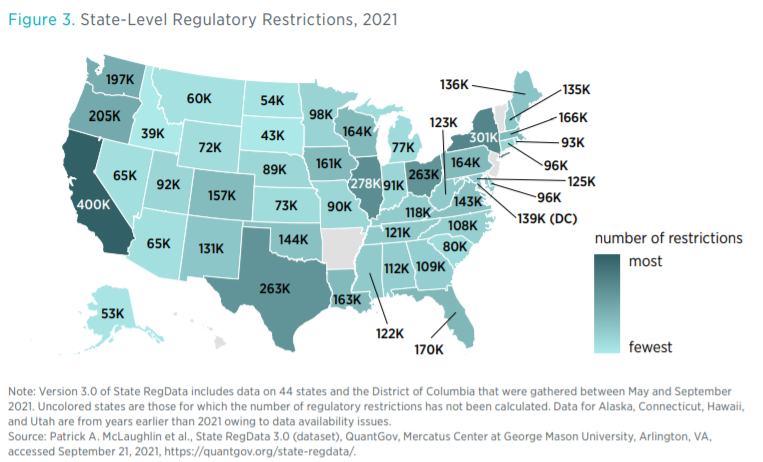
One reason technology is needed to make sense of state administrative codes is they are too long for individuals to read from start to finish. The Kansas Administrative Regulations, for example, contains about 3.3 million words (see figure 4). It would take a person about 185 hours, or roughly four and a half weeks, to read the code at a normal reading pace if the person were to read 40 hours a week as a full-time job. Kansas is actually the least regulated state in the nation in terms of the number of words in its administrative code. For comparison, the California Code of Regulations contains more than 21 million words, and the US Code of Federal Regulations includes about 103 million words.

Tens of thousands of requirements are interspersed within these words. Based on a count of restrictive terminology, a slightly different picture emerges of the regulatory environment in Kansas. Kansas has 72,645 regulatory restrictions as of 2021. By this measure, Kansas is no longer the least regulated state but instead becomes the eighth-least-regulated state, behind Idaho, South Dakota, North Dakota, Montana, Nevada, Arizona, and Wyoming. Nevertheless, Kansas’s regulatory volume remains significantly less than the US average of about 136,000 regulatory restrictions and also less than the average of states in the Plains region, as defined by the Bureau of Economic Analysis (see figure 5).

RegData also allows researchers to identify which regulatory agencies or departments are producing the most regulations as well as which industries are being targeted by rules. The Kansas Department of Health and Environment is by far the biggest regulator in Kansas in terms of regulatory restrictions. This single department oversees an estimated 19,397 restrictions. Meanwhile, the second-biggest regulator in the state, the Kansas Racing and Gaming Commission, has about 5,007 regulatory restrictions in its rules, approximately a quarter of the number promulgated by the Department of Health and Environment. The most regulated industries in Kansas are, perhaps not surprisingly, given the disproportionate size of the Department of Health and Environment, manufacturing, energy, transportation, various kinds of food industries, and social assistance (see figures 6 and 7).
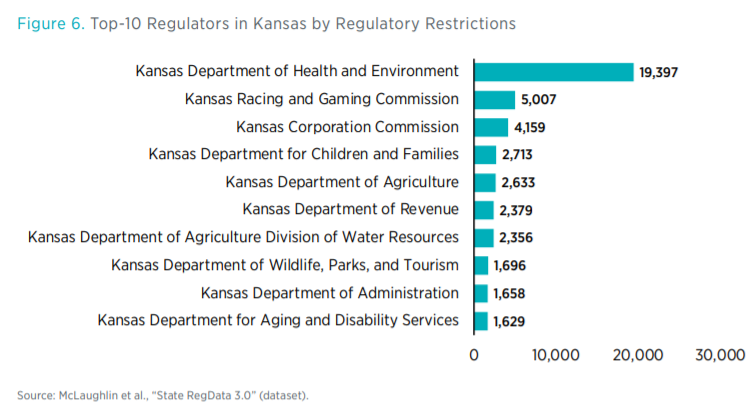
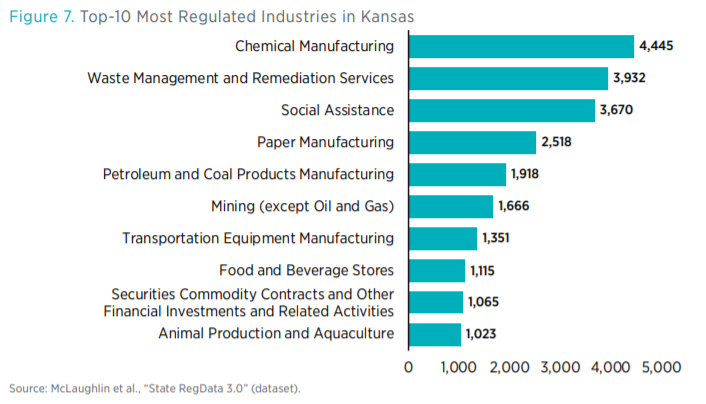
Some argue that it makes sense to adjust for population when reporting regulatory restrictions. Less populous states might have fewer industries than more populous states, thereby necessitating fewer regulations. Or perhaps regulatory costs fall on a per capita basis as the population grows (perhaps as a result of the fixed costs of setting up regulatory institutions). Figure 8 presents the number of regulatory restrictions for each 1,000 residents in the Plains states. Kansas is the fourth-most-regulated state in the Plains region by this measure, having about 24.9 restrictions per 1,000 people in the population. South Dakota has the most restrictions in the region by this measure (52.6), and Missouri has the least (14.6). Michigan (7.7) is the least regulated state in the nation on a population-adjusted basis, and the District of Columbia (196.8) is the most, followed by Wyoming (125.0).
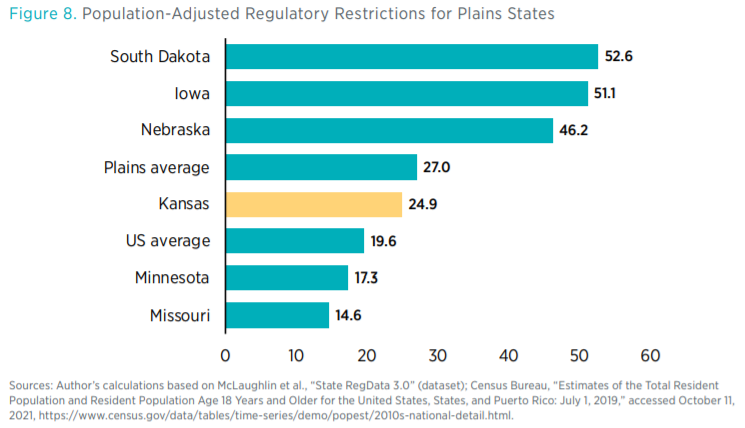
Learning from the Canadian Experience
Kansas appears to be keeping its regulatory burden light relative to other states. Nevertheless, there are still lessons the state can learn from other jurisdictions with respect to fine-tuning its regulatory processes. Canada, for example, has been at the forefront of regulatory reform efforts in recent times. In particular, the province of British Columbia implemented reforms starting in 2001 that led to a reduction in the number of regulatory requirements of 49 percent. In other words, while most jurisdictions across the world tend to see levels of regulation go up year after year owing to regulatory accumulation, British Columbia saw the opposite. Over time, British Columbia has cut rules and kept cutting.
In the years leading up to British Columbia’s regulatory reform effort, the province was, like the United States, experiencing disappointing growth. British Columbia was considered an economic laggard and was the worst performing major province in Canada in terms of GDP per capita growth in the 1980s and 1990s (see figure 9a). However, following the province’s regulatory reforms (and some other economic reforms) British Columbia became a top performer in Canada (see figure 9b).
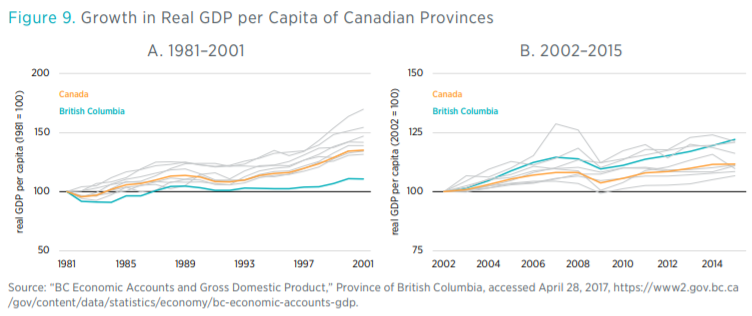
British Columbia policymakers set an initial goal of reducing regulatory requirements by one-third. Recent empirical research estimates that achieving this goal increased the economic growth rate of the province by about 1 percentage point annually. Perhaps most important, this growth did not come at the expense of public health or the environment. There were no major controversies arising from these reforms. In fact, throughout its reforms British Columbia was known as one of the healthier and more environmentally pristine places in Canada.
Eight Things Kansas Can Do to Improve Its Regulatory Environment
Although, Kansas appears to be doing many things right, no state is perfect, and there are some shortcomings with Kansas’s administrative rules system worth noting. For one thing, the state’s Administrative Procedures Act does not have a periodic review requirement. A periodic review requirement is a provision that says regulators must look back and reevaluate their rules on some schedule to assess those rules’ performance. If regulators never look back, they won’t know whether rules are working.
Kansas tried to address this shortcoming a few years ago when it created an Office of the Repealer. However, this office has not proved to be an enduring feature of the regulatory system. One explanation for the lack of permanence of the office may be that the office was created via an executive order, rather than legislation. It may not have had significant authority over other departments as a result. Indeed, the executive order creating the office was eventually rescinded by the creator of the office, former Governor Sam Brownback.
The following options would help Kansas get its regulatory review and oversight efforts back on track. These options are not mutually exclusive, and the state could implement them in any order or combination to great benefit.
Option 1: Embed Regulatory Reform Officers within State Agencies to Identify Outdated Regulations
One way to improve on the idea behind the Office of Repealer would be to, instead of having an independent office focused on cutting red tape, embed individuals whose job is to identify problematic regulations within the regulatory agencies themselves. This was an approach taken in Idaho as well as by the Donald Trump administration. Rule review officer positions were created to facilitate regulatory review and to work in a coordinating fashion with the administrations in charge. This design appears to have worked fairly well. These reforms could prove more enduring if positions are created via legislation and empowered with certain authority surrounding the removal of outdated regulations.
Option 2: Create a Bipartisan Commission Comprising Executive and Legislative Branch Officials to Review Existing Regulations and Make Recommendations for Reform
Another option would be to create a commission whose responsibility is to review regulations. Though in some respects not that different from the Office of the Repealer idea, the benefit of a commission is it can bring together a variety of interests and power sources within government so that regulatory reforms draw on consensus and have broad political support behind them. New Jersey during the Chris Christie administration created a Red Tape Review Group and subsequent Red Tape Review Commission to review outdated regulations. The commission issued annual reports outlining problematic regulations and detailing areas where statutory changes could help make improvements to the regulatory system. Many of these ideas were subsequently implemented. The commission was bipartisan and independent—it comprised members of the governor’s cabinet as well as minority and majority members from the legislature.
Mississippi may also be a model. The state has an Occupational Licensing Review Commission, which, among other things, has the power to order boards and commissions under its authority to amend or even repeal regulations. The commission also reviews new regulations and has required economic analysis from regulators as part of its reviews.
Option 3: Adopt Sunset Provisions for State Regulations
Kansas could benefit from formal procedures requiring state agencies to periodically review their rules. One way to force agencies’ hands would be to pass a law attaching sunset provisions to state regulations. A sunset provision is an expiration date built into regulations whereby they automatically expire after a certain amount of time has elapsed. In order for a regulation to continue, it must therefore be reissued or reauthorized in some way. Important factors to consider when designing sunset provisions are who should have the power to reauthorize rules (usually the regulating agency or the legislature) and what criteria should be evaluated when reviewing regulations. Indeed, legislation was introduced in Kansas in 2020 that would have attached a five-year sunset to regulations.
Option 4: Implement Red Tape Reduction Legislation to Reduce the Volume of State Rules
One might ask why one of the more lightly regulated states in the nation might want to cut regulations. Here the experience of the state of Idaho can be instructive. In terms of regulatory restrictions, Idaho was the fourth-least-regulated state in 2019. Nevertheless, that year the state underwent a dramatic regulatory reform whereby it sunset its entire state administrative code, replacing it with a new, more streamlined version. In the process, Idaho cut regulatory restrictions by 37 percent, becoming the least regulated state in the nation by this measure.
Kansas could follow Idaho’s lead by implementing red tape reduction legislation following the model of British Columbia. Similar legislation has been introduced in Ohio that, if passed, would require state agencies to reduce regulatory restrictions by 30 percent across the board. Kansas could also experiment with a pilot program—as Virginia has—focused on regulatory reductions at specific agencies, such as occupational licensing regulators. If a pilot program goes well, the red tape cutting effort can be expanded to other agencies and departments. Virginia’s two pilot program agencies reduced regulatory requirements by 27 percent and 14 percent, for example.
Many red tape reduction efforts in states have focused on simple measures of regulation, such as counts of regulatory requirements or restrictions, and have set goals on the basis of those metrics. British Columbia set a 33 percent reduction goal in 2001. More recently, Kentucky set a 30 percent reduction goal, Missouri set a 33 percent goal, and Oklahoma set a 25 percent goal. Like a compass in the hands of a ship captain, reduction targets guide regulators where they want to go and let them know when they’ve arrived at their destination.
Option 5: Enact a PAYGO Provision Whereby New Regulatory Requirements or Costs Must be Offset by Eliminating Old Ones
An alternative to a reduction goal is to establish a pay-as-you-go (PAYGO) system whereby new regulations added are offset by reducing existing regulations. This reform could help Kansas lock in its current low level of regulation so that regulatory accumulation doesn’t erode the state’s competitive edge. There are several variants of this approach. Texas has a system whereby the costs of existing regulations must be eliminated when new regulations imposing positive costs are added. Alternatively, Ohio passed legislation requiring that two regulatory restrictions be eliminated for each new one added. Ohio used a simpler metric whereby rules with regulatory restrictions include the words shall, must, require, shall not, may not, and prohibit.
Option 6: Strengthen Economic Analysis Requirements by Creating an Independent Office in the Legislature to Analyze Regulations and Their Effects
There are tradeoffs involved with selecting the measure that guides regulatory reform efforts. In theory, it would be preferred to have cost and cost savings estimates for every regulation. In practice, producing credible cost estimates for regulations requires analysts, which is itself costly. That said, some states are investing in staff to produce credible cost estimates for regulations. One notable example comes from West Virginia, with its Division of Regulatory and Fiscal Affairs. An interesting feature of this office is that it is housed in the legislature rather than in the agencies that regulate. This independence makes it more likely that the division’s analysis will not be unduly influenced by political factors. The division is led by a PhD economist who has the support of four fiscal analysts, meaning that West Virginia has invested significant resources in regulatory analysis capabilities.
This point is important because sometimes it takes money to save money. In this case, it takes hiring people with the skills and training to produce analysis competently to save the public money through reduced regulatory burdens. Economic analysis of regulations can also be a helpful way to identify wasteful state expenditures and close budget gaps. Kansas does have some economic analysis requirements, but the types of analysis required are performed by the agency responsible for a particular regulation. Combining analysis requirements and housing the responsibility for producing analysis in an independent office, preferably in the legislature, could streamline analytical requirements and result in more objective and higher-quality analysis.
Option 7: Create a Fast-Track Process for Repealing Regulations
Once enacted, rules create constituencies that benefit from their existence and will lobby to keep them in place, making it easier to add rules than take them away. As a result of this asymmetry, some states have created fast-track procedures for repealing regulations. The process usually works by allowing state regulators to sidestep standard administrative procedures so long as the regulators seek and receive approval from a regulatory oversight committee in the legislature. North Dakota and Oklahoma have fast-track procedures along these lines, for example.
Option 8: Require Formal Rulemaking Procedures for Some or All State Regulations
Kansas should consider creating what is known as a “formal rulemaking” process for regulations. Regulators in most states (including Kansas) follow what is known as “informal” (or notice and comment) rulemaking. Under informal rulemaking, regulators first propose a rule, then accept comments from the public on the proposal, and then respond to those comments before issuing the rule in final form. Formal rulemaking, by contrast, involves a trial-like procedure, usually overseen by an administrative law judge. During the hearing, the state agency may present witnesses who can be cross-examined by members of the public. Interested parties might also call opposing witnesses and present evidence that conflicts with that presented by state witnesses. The regulating agency may also have to meet a higher burden of proof when promulgating a rule.
Minnesota is a model in this regard. Kansas could create a process whereby certain very impactful rules, or even all state regulations, must follow formal rulemaking procedures. Though doing so involves more work for agencies upfront, it can save time and money on the back end through reduced litigation costs (because fewer questionable rules get enacted in the first place) and improve regulatory outcomes by requiring a stronger evidence base for rules before they may go into effect.
Conclusion
Despite a relatively low regulatory burden compared with other states, small businesses in Kansas have a relatively unfavorable view of the regulatory environment. Surveys of small businesses gave the state a grade of B− on its licensing, labor, and business startup rules. Meanwhile other states such as Georgia scored an A+ on these criteria. Thus, Kansas has room for improvement, especially from a small business vantage point. To review, the following are eight reforms Kansas policymakers should consider adopting soon to improve the state’s regulatory environment.
- Embed regulatory reform officers within state agencies to identify outdated regulations.
- Create a bipartisan commission comprising executive and legislative branch officials to review existing regulations and make recommendations for reform.
- Adopt sunset provisions for state regulations.
- Implement red tape reduction legislation to reduce the volume of state rules.
- Enact a PAYGO provision whereby new regulatory requirements or costs must be offset by eliminating old ones.
- Strengthen economic analysis requirements by creating an independent office in the legislature to analyze regulations and their effects.
- Create a fast-track process for repealing regulations.
- Require formal rulemaking procedures for some or all state regulations.
In addition—or instead of—these cross-cutting procedural reforms, Kansas could also enact more tailored reforms (for example, a pilot program) to home in on specific areas where there might be the most consensus that red tape is a problem. Potential areas of consensus might include occupational licensing regulations, housing restrictions, permitting procedures, or other areas prone to overregulation and special interest favoritism.
With regard to occupational licensing, as of 2017, Kansas was one of the more burdensome states in terms of its licensing of preschool teachers, athletic trainers, mobile home installers, veterinary technicians, and barbers. Kansas need not eliminate a license altogether to make it less burdensome. Fees and training requirements could be reduced, for example, or a license could be turned into a registration requirement, thereby maintaining some state oversight.
Another licensing-related reform would be the passage of a reciprocity bill, like Arizona’s, whereby a state accepts licenses from states that accept its own licenses. Or alternatively, Kansas could focus on expanding scope of practice for some professionals. For example, pharmacists can prescribe an increasing array of medications in some states. This kind of reform could expand healthcare access while reducing costs by increasing supply of care.
All told, Kansas does a lot of things well with respect to regulating its residents. Nevertheless, the state could do more. Given the advantages in terms of talent and amenities that large cities and states have to offer, smaller, less populated states have to go the extra mile to lure away top talent and firms. It is well established that regulations that impede entry into particular industries reduce productivity and growth, ultimately lowering social welfare. Why should Kansas shoot itself in the foot with restrictions that essentially tell businesses to go elsewhere?
This policy brief has cast a light on areas where Kansas can improve and offered some options to the Sunflower state that it can use to achieve regulatory reform. These tools can assist the state as it aims to move from good to great in terms of its regulatory system.
